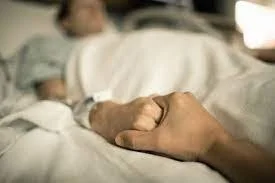Article 21 of the Indian Constitution entails the fundamental right to life, a life of dignity and meaning. So, what happens when one deems one’s life to be meaningless and a source of distress? What kind of distress is accepted by the law that will allow one to access their right to die, which lies on the continuum of Article 21? In India, the Right to Die became a fundamental right on 9th March 2018 under Article 21 of the Indian Constitution, with Common Cause filing the petition. Patients who are terminally/chronically ill have to put their wish to deny treatment in their living wills or Advanced Medical Directive (AMD) when they are not able to communicate their wishes. In case of hospitalisation, a panel of medical practitioners, lawyers and social scientists are to determine if the AMD is to be executed. Then subsequent changes were made to streamline the process of dying with dignity and to reduce the bureaucratic burden on the Judicial Magistrate.
Medical professionals differ in their opinion of the morality of active and passive euthanasia. In active euthanasia, the patient voluntarily and actively administers the lethal injection or drugs that gradually ebbs them away. While in passive euthanasia, medical professionals withdraw life-prolonging treatment. Ethicists, on the other hand, believe that active euthanasia is “quicker and cleaner”, as it allows the patient to choose to not suffer the pain and die in a dignified manner. Patients in palliative care have a looming fear that they will burden their loved ones, and hence opt for Medical Assistance in Dying (MAiD).
The end-of-life decision is argued to be in stark opposition to the physician’s duty to heal the patient and brings moral obligations on medical practitioners to weigh in on the patient’s decision. It eventually ignites philosophical, religious and cultural beliefs of practitioners.
Patients who request MAiD have mostly been through the palliative care system. If not, then euthanasia consultants refer them to one, but the decision is sometimes dependent on preceding discussions. There is an existing disparity in the US healthcare system that needs to be addressed by considering cultural differences in the country. It has been seen that the white population disproportionately accesses MAiD, and cultural and religious factors may play an important role. Another factor is the cost of death and access becomes difficult for people belonging to lower socio-economic class.
Katie Englehart, a journalist at New York Times, interviewed Maia for her book “The Inevitable: Stories of Life, Choice and the Right to Die”, a multiple sclerosis (MS) patient who was diagnosed at the age of thirty-three. The disorder progressively made her immobile and eventually made her homebound and dependent on her partner. In the US, the law did not allow her to opt for assisted dying as she was not bad enough. When it comes to MS patients, things can get a bit tricky; as it is an auto-immune disorder, where our body destroys the fatty covering called myelin sheath of the neurons in the central nervous system (CNS), which progressively causes a collapse in the communication web of our body. This deficit makes movement jerky and uncontrollable, can cause vision loss, pain, cognitive impairment and paralysis among others. Patients with MS can edge away from life slowly or at a rapid pace depending upon the type. So, when death is medically foreseeable within 6 months, patients would not qualify for assisted dying as their ability to self-administer the drugs becomes impossible.
Around the world, MAiD is still a controversial topic but quite a few countries have legalised it for terminally ill patients mostly with a prognosis of 6 months or less. However, fewer countries have made MAiD legal for psychiatric disorders, given that they are not experiencing suicidal ideation and have made their decision by duly considering its irreversibility. Countries like Switzerland, Belgium, Netherlands and Luxembourg have legalised MAiD for psychiatric illness. However, as these populations are already at risk of distorting perspectives, consulting experts must be very vigorous and thorough with their analysis and reach a conclusion that would ultimately benefit the patient.
Switzerland has witnessed a rise in “suicide tourism” that allows foreigners to access MAiD. Article 115 of the Swiss Criminal Code states:
Inciting and assisting suicide: Any person who for selfish motives incites or assists another to commit or attempt to commit suicide shall, if that other person thereafter commits or attempts to commit suicide, be liable to a custodial sentence not exceeding five years or to a monetary penalty.
So, the interpretation is based on the omission; that if someone assists an individual whose life has become unbearable must do so with unselfish motives. Clinics like Dignitas, and Life Circle, are keeping a thorough check to ensure that the law is not misused in any way.
MAiD for mental illness is a controversial topic in Canada, and the implementation is constantly being delayed from 2023 to 17th March 2024, which has been delayed further. John Scully, a former journalist, based in Canada was documented by BBC. He is an 82-years-old man who has been suffering for the last 40 years from severe depression, anxiety, somatic pain and PTSD. Currently he is on 30 pills a day after he sought several treatment menthods and two failed attempts to die by suicide. The debilitating state of his illnesses make it quite difficult for him to go on with life. So, people like John are still hopeful of being included in the program and finding a respite to their suffering.
Assisted dying is a way through which people try to control the way they die. Should we rethink our idea of death? And if we do, what will be the cultural implications of such a move?
Saswati Deb


